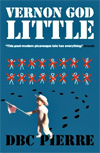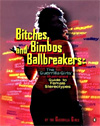




 |
 |
Pointing Fingers
Antiheroes and Guerilla Girls expose universal truths
by Julia Watts
Are some things in life just too serious to be used as fodder for humor? Many people, mindful of the world’s atrocities, would answer that question with a grim “yes.” But if they read DCB Pierre’s Vernon God Little (Canongate, $23), a darkly comic novel about the aftermath of a school shooting, they might change their minds.
Vernon Little is a small-town Texas teen whose thoughts don’t go much beyond the pleasures of wearing new Nikes and ogling Victoria’s Secret models. But when his best friend Jesus shoots 16 of his high school classmates and then himself, Vernon’s problems become much more serious than worrying about whether his mom will discover that he’s been stealing her lingerie catalogs.
Vernon’s dismal hometown of Martirio, Texas, becomes the site of a media feeding frenzy, and the school shooting is, if not the flavor of the month, the tragedy of the month. One of the hungriest media sharks in this feeding frenzy is Eualalio Ledesma, a small-time TV repairman with designs on becoming a CNN anchor. Ledesma manipulates his way into the Little family by courting Vernon’s lonely widowed mother and is soon using a combination of TV footage and media spin to make Vernon look as guilty in the shooting as the deceased, and therefore impossible to punish, Jesus.

Desperate for vengeance, the public makes Vernon its scapegoat, and soon the clueless teen finds himself starring on a top-rated reality show set on Death Row. Still, Vernon manages to stay optimistic, asking, “Why do movies end happy? Because they imitate life.”
Like the love child of Eminem and Holden Caufield, Vernon Little peppers his speech with profanity while remaining innocent—a quality that allows him to see the hypocrisy of the people who surround him.
The kookiness of Vernon and the other characters in the novel has led critics to compare Vernon God Little to John Kennedy Toole’s A Confederacy of Dunces. It is true that many of Pierre’s creations would not look out of place in Toole’s book: Vernon’s guilt-inducing mother, the lecherous psychiatrist who tries to take liberties with Vernon, the crassly ambitious media hound Eulalio Ledesma. In the end, though, Vernon God Little is a more thematically ambitious novel than A Confederacy of Dunces. While Confederacy is a rollicking farce, Vernon is a razor-sharp satire that flays open the heart of a media-manipulated America where, in the face of tragedy, people are too hungry for vengeance to listen to reason.
For a funny non-fiction take on our cultural hypocrisies, check out Bitches, Bimbos, and Ballbreakers: The Guerilla Girls’ Illustrated Guide to Female Stereotypes. A group of feminists who take the names of dead women artists and appear in public wearing gorilla masks, the Guerilla Girls have been criticizing, deconstructing, and generally thumbing their noses at gender stereotypes for almost two decades.
In Bitches the Guerilla Girls take a tongue-in-cheek look at various stereotypical images of women, such as the daddy’s girl, the tomboy, the vamp, the dumb blonde, and the ever-popular bitch. The Guerilla Girls discuss both real-life and fictional women who have been pigeonholed by these stereotypes and do an especially good job analyzing how women are often stereotyped because of their sexual behavior.

While Bitches is both fun and insightful, I do have one small complaint. Despite the fact that the book’s bibliography is fairly long, the Guerilla Girls’ research seems less than rigorous at times. For example, in their discussion of the novel Lolita, they write, “Lolita redeems herself with an early marriage and pregnancy—and there the book leaves her, with no hint about her ultimate fate.” Actually, the first section of the novel tells readers that the Lolita dies in childbirth.
Another gaffe occurs in the section on flappers when the authors theorize, “The name flapper probably came from the fledgling young bird who makes a commotion learning to fly out of its nest.” Well, no. The name came from the unfastened, flapping galoshes the young women wore.
Bitches, Bimbos, and Ballbreakers is not meant to be a serious piece of scholarship, but a humorous and biting look at the narrow roles that have traditionally been forced on women. Its wit and its excellent collection of photographs, which both illustrate and subvert stereotypes, make it well worth perusing.

April 1, 2004 • Vol. 14, No. 14
© 2004 Metro Pulse
|
|